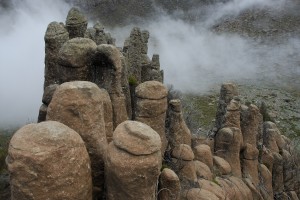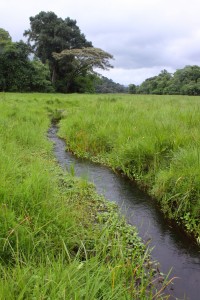Geology & Glaciation
The Bale Mountains were formed prior to the creation of the Rift Valley, from lava outpourings, which covered all underlying rock formations between 38 and 7 million years ago. The rocks of the volcanic outpourings are predominantly trachytes, but also include rhyolites, basalts and agglomerates, and tuffs. The Bale highlands area consists of a vast lava plateau with at least six volcanic cones, each more than 4,200m. These cones have been considerably flattened by repeated glaciations.
There have been at least two glacial periods in the history of the mountains. These specific mountains were glaciated as little as 2,000 years ago. During the last ice age, the Bale Mountains were one of the most extensively glaciated areas in Ethiopia, with a total of approximately 180km2 of ice. There was a 30km2 ice cap around the peak of Tulu Dimtu on the Sanetti plateau and individual glaciers of considerable thickness reached down to 3,200m. As a consequence, the landscape as we see it today is the lava outpourings modified by over 20 million years of erosion by water, wind and ice.
There are certain geological features that remain an enigma to geologists and glaciologists, such as the striations (or boulder grooves) that appear on shallow hillsides on the Sanetti plateau. Boulder grooves, till ridges and numerous glacial valleys, such as the Togona Valley on the northeastern slopes of the Sanetti plateau, provide evidence of the ice age effects on the landscape of the Bale Mountains National Park. Until the beginning of de-glaciation (13,000 to 14,000 years ago), the snowline was at 3,700m and the upper tree limit in the Bale Mountains was well below 3,000m. Fluctuations in climate over the last historical period, including the last 3,000 years, have dramatically affected vegetation and other biodiversity in the highlands.
Hydrology
Over 12 million people are crucially dependent on water from the Bale massif for four reasons. Firstly, the Bale massif plays a vital role in climate control of the region by attracting large amounts of orographic rainfall (rainfall that occurs when wind encounters a land mass and is forced upward), which has obvious implications for agriculture. Some 600mm to 1,000mm fall annually in the lower altitude areas, while 1,000mm to 1,400mm fall in areas of higher altitudes.
Secondly, a total of 40 rivers rise in the national park area, contributing to five major rivers: the Web, Wabe Shebele, Welmel, Dumal and Ganale. Additionally, the Bale massif is the source for many springs in the lowlands, which are of paramount importance as they are the only source of water year-round. The people of the south are completely dependent on good management of the water resources from the highland areas. If the flow of these rivers is altered in any way - through deforestation, overgrazing and/or over abstraction for irrigation (all of which are occurring at present) - a highland/lowland imbalance results with loss of perennial water in the lowlands. If such a situation arises, the dry season range of the people and their livestock reduces dramatically and they congregate around whatever water source remains. It is widely recognized that such an uneven distribution of people and livestock leads to rapid and lasting degradation. The people are, therefore, likely to become increasingly food-aid dependent if the water catchment areas of the Bale Mountains are insufficiently protected. There is already evidence that over-abstraction of water in the Bale Mountains is occurring.
Thirdly, two rivers originating from Bale – the Wabe Shebele and Yadot (a tributary of the Ganale) – have hydroelectric schemes. The dam on the Yadot River supplies electricity to Delo-Mena, while the dam on the Wabe Shebele provides electricity to the Bale area.
Lastly, there are numerous natural mineral water springs, called hora, which are locally believed to provide an essential source of minerals for livestock. The mineral springs within the park are valued for their high mineral content (sodium, potassium, magnesium, zinc and calcium), drawing people from far away for the benefit of their cattle. Local pastoralists believe that in order to maintain good health and milk production, the livestock must be given hora water. They drive their livestock for up to two days to reach the hora springs.


